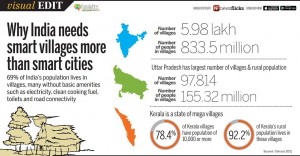Why concentrate on villages?
- Almost 70% of the Indian population lives in villages. In recent times, more cases of farmers’ suicides due to crop failure have been reported. Even after 70 years of independence, we lack a ‘support and guidance system’; nor do we have professional counselling for farmers. Many of them have no secondary source of income — this is a major lacuna.
- The lack of job opportunities in villages coupled with less remunerative farming (except in the case of large land holdings) compels village youth to migrate to cities. There, many of them do not enjoy a reasonable quality of life because they manage to get only subsistence jobs.
- The migration is also unidirectional as they continue to live in cities in the hope of landing better jobs. In the long term, this leads to desertion from villages, dilution of village culture, reduced land under cultivation and, consequently, farm output.
- In the cities, uncontrolled migration adds to pollution, traffic problems, crime, and over-burdening of civic amenities and infrastructure. Therefore it is natural that for ‘inclusive’ development, the Government must focus on them.

Present scenario:
- According to the most recent socioeconomic and caste census data, a third of India’s rural households are landless and dependent on manual labour for an income.
- About 13% of rural households are still only one-room tenements built with mud walls and fragile roofs.
- There is not even basic health insurance in case of serious illnesses. Rural health centres are not easily reachable, and even if they are, they don’t have either the facilities or the medicines to treat anything other than diarrhoea and bacterial infections.
- Malnutrition is widespread and one of India’s most enduring enigmas.
- Roads in the interiors are also not in good condition. They are difficult even to walk, not to speak of travelling by carts, and have been in that condition for years.
What needs to be done?
- The top priority should be the creation of opportunities for youths in villages, thereby discouraging migration to cities. We must create an eco-system that makes youth interested in working from their villages. BPOs/KPOs can operate from villages and young people can be encouraged to take up IT jobs there. Many jobs require computer skills instead of degrees. The digitisation of post offices, rural banks, and IT-enabled services provide excellent opportunities.
- Farming should be made a remunerative occupation, with guidance and mentoring to small farmers on how to get the best yield and market at remunerative prices. It’s important to train them to develop a secondary source of income.
- The benefits of schemes such as crop insurance, soil health card, and neem pesticides must reach the grassroots. Proper implementation is key. A helpdesk set up in every village and manned by trained individuals to handle farmers’ queries and provide solutions would be most useful.
- Projects supported by Digital India and Skill India should be integrated through a unified agency to reach villages. For instance, Skill India can empower youths to start their own small businesses after training as masons, mechanics, electricians, and drivers or to run repair shops, poultry and dairy farms, kirana stores, tea-shops, dhabas and so on.
- India’s crafts thrive in villages, especially as cooperative ventures. Pottery, metal craft, weaving, jewellery making, wood craft, shell craft, cane craft, embroidery, ivory craft, glass craft and paper craft could be sources of income. The arts and crafts ecosystem of villages is impossible to recreate in cities. A great deal of export potential is hidden here. Senior/elderly artisans can be employed as ‘trainers’.
- Villages traditionally preserve large number of water bodies like ponds, wells, bawadis, canals etc. Training villagers in water harvesting methods, rejuvenating ponds/wells to improve water storage and sharing these good practices systematically with others, would help mitigate hardships.
Things to consider while making villages smart:
Basic facilities should include health and sanitation, housing, power, skill development centres and micro-industries.